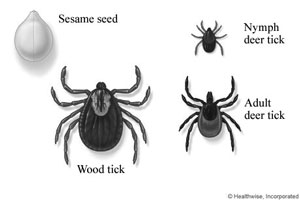Alberta Health Services (AHS) is again operating its “Submit-A-Tick” surveillance program.
Anyone who finds a tick on themselves, someone else, or their pet, or finds a tick outside, is able to submit it to Alberta Health Services for testing.
This is the second year for the program. A voluntary program with AHS receiving ticks from veterinarians began in 2007.

Alberta is continuing its Submit-a-Tick surveillance program, asking anyone who finds a tick to submit it for testing.
AHS asks people to phone and make an appointment for the tick drop off. Locally, to the Drumheller Environmental Public Health Office at (403) 823-3341, and at the Hanna Health Centre at (403) 854-5261.
Valley Veterinary Clinic only accepts ticks found on pets, and they ask that people call first at (403) 823-5400.
Ticks are sent to Edmonton to find if they’re carriers of Borrelia burgdorferi, the bacteria that can cause Lyme disease in humans.
“Results of this program will help Alberta Health better understand the risk of Lyme disease in Alberta,” AHS states.
The AHS site displays statistics showing that between 1998 and 2013, 51 cases of Lyme disease were reported to Alberta Health. All were reported as having been acquired while travelling outside of the province.
The website is at www.health.alberta.ca/health-info/lyme-disease.html., and has instructions on the safe removal and storage of ticks for drop off.
A completed list of AHS Environmental Health locations participating in “Submit-A-Tick” can be found there as well.
To protect from tick bites, AHS suggests:
- cover as much skin as possible when going into grassy or wooded areas. Wear a hat, long sleeved shirt, and long pants with the legs tucked into the socks.
- wear lightly coloured clothing to more easily spot ticks.
- use a spray that contains DEET to repel ticks.
- check yourself for ticks after you’ve been outside.
AHS analyzed 960 ticks in 2013 that they received from across Alberta.
Of those, they found 139 adult blacklegged ticks that were likely acquired in Alberta, not while travelling outside the province. Health Services notes it is not possible to know if the blacklegged ticks are established in Alberta.
They found one in five blacklegged ticks were positive for the Borrelia burgdorferi bacteria. Most of those were submitted from the greater Edmonton area.
MyHealth.Alberta.ca cites western blacklegged ticks, along the pacific coast, mostly in southern British Columbia, and deer ticks, in the eastern and south-central areas of Canada, as the carriers of Borrelia burgdorferi in Canada.
They recommend ticks be removed as soon as they are noticed, adding infected ticks usually don’t spread Lyme disease until they’ve been attached for at least 36 hours.
Ticks can carry other organisms that may cause diseases in humans such as Rocky Mountain spotted fever, Powassan virus and Tularemia.
AHS figures there are zero to three cases of these diseases reported to Alberta Health each year, mainly locally-acquired cases.



























